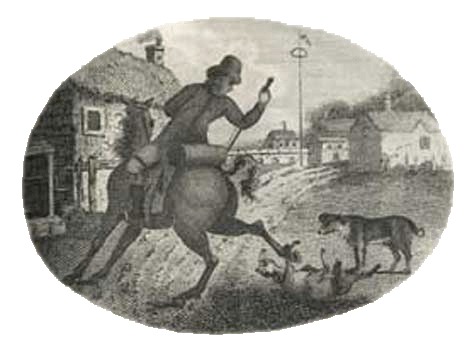Changes in Publishing and Bookselling
As English publishers sought to satisfy the country’s growing readership, books needed to “stand out” among the greater volume of titles being produced. Use of illustrations was one technique increasingly employed to capture readers’ attention. Advertising was another; advertisements appeared in newspapers, prospectuses were available at bookshops, and publishers issued catalogs of their offerings and their prices. Some publishers sought new markets, such as America, while others gave their books larger press runs. Although large folios remained popular, more and more smaller volumes—quartos, octavos and duodecimos—appeared to serve the new, more mobile urban middle class, who could carry these smaller volumes with them “on the go.”
As England’s rural society gave way to a more urban one, bookshops became more permanent fixtures in the developing towns. At the dawn of the 18th century, the peddler with a cart full of books was still a familiar figure in the countryside, but the traveling peddler eventually gave way to the established shopkeeper. In 1700, an estimated 190 members of the book trade operated in about 50 towns; twice that number operated in 174 towns in the mid-1740s, and about 1,000 operated in more than 300 towns by the 1790s. Some oversaturation was inevitable; bankruptcies became common in the last quarter of the century.
At first, London booksellers resented and feared competition from their provincial brethren. The London members of the trade held private book auctions and trade sales— and the country sellers were not invited. Thus, authors could not sell their copyrights outside the London circle if they wanted their work to have a reasonable chance of success. However, later in the century, the London printers and publishers realized that country booksellers could actually help them reach provincial markets, so a spirit of cooperation developed, in which London was the production center and the country sellers were retailers. Improvement in road construction and maintenance during the 18th century bolstered the exchange.
The country booksellers also served as distribution centers for provincial newspapers, as well as London periodicals. In addition, these bookshops often sold stationery; they received a boost in the 1730s, when England became self-sufficient in making paper after relying on imports for centuries. Many also sold patent medicines, the market for which was fueled by newspaper advertisements. Some worked as insurance agents and grocers, in addition to selling books. By the end of the century, however, the book business was sufficiently profitable in itself to no longer necessitate these “side ventures.”

